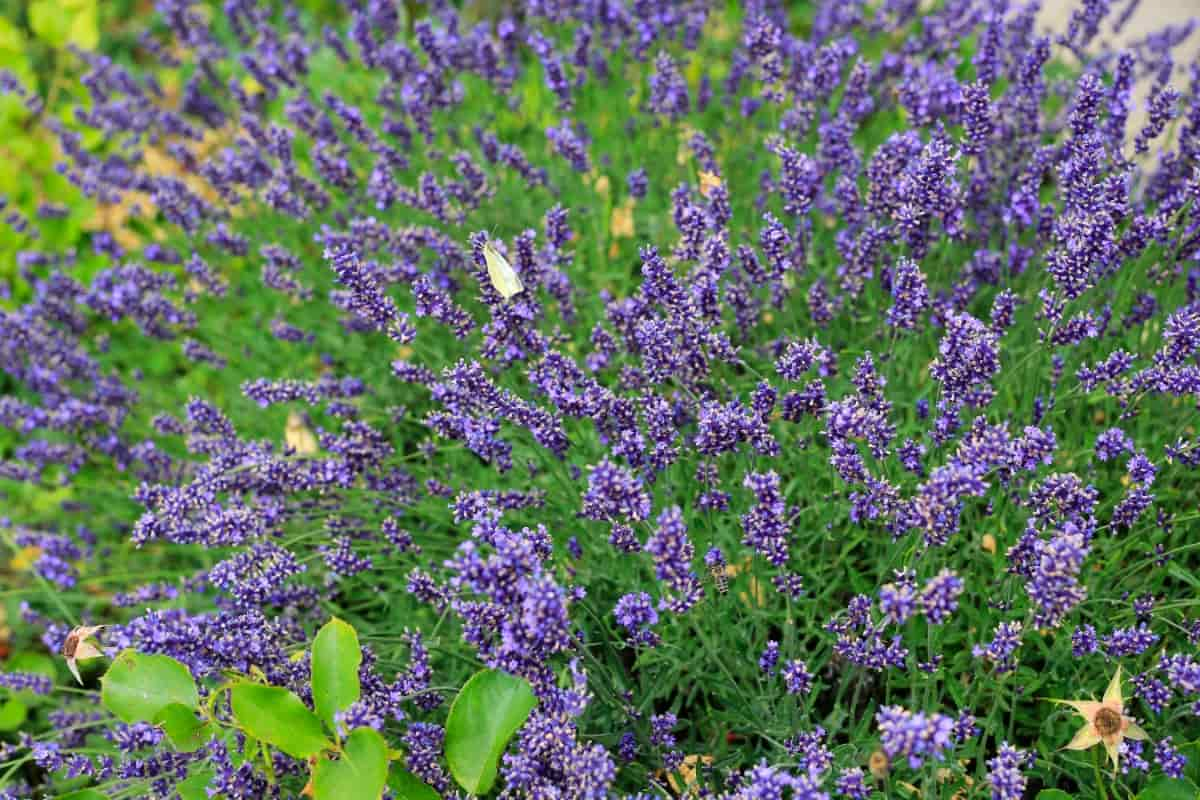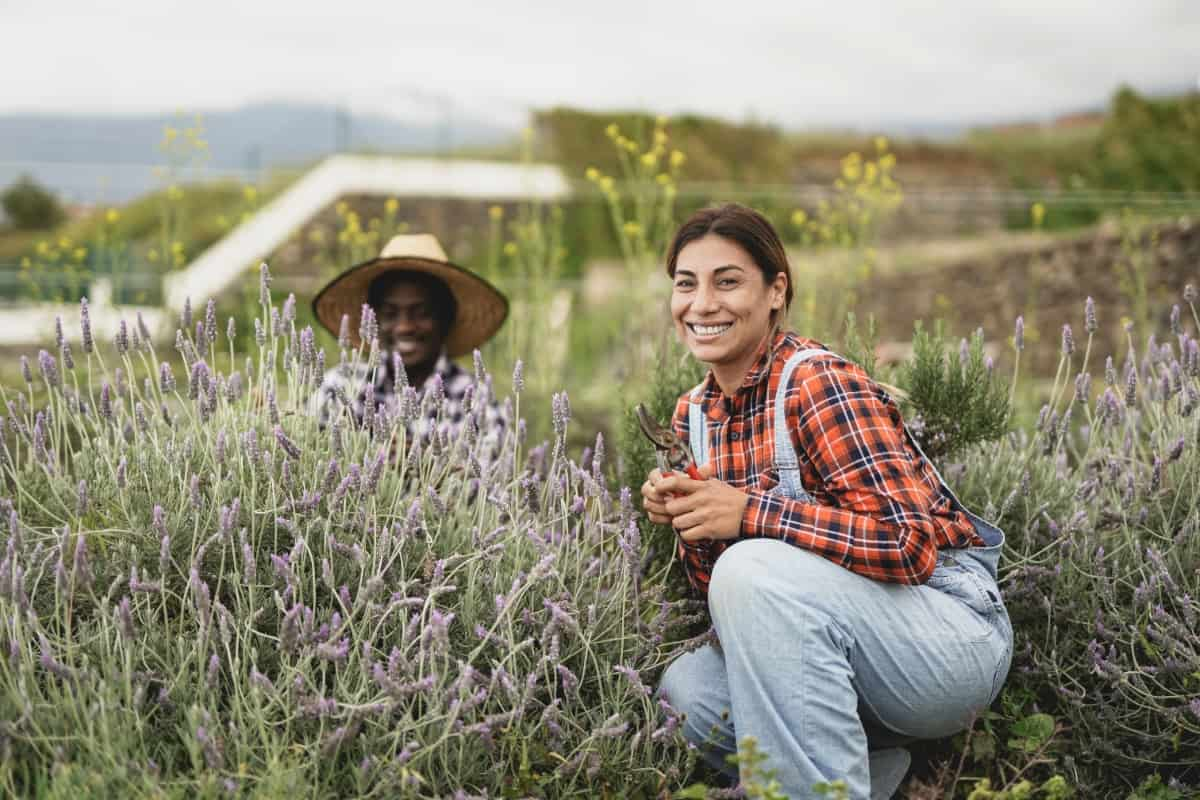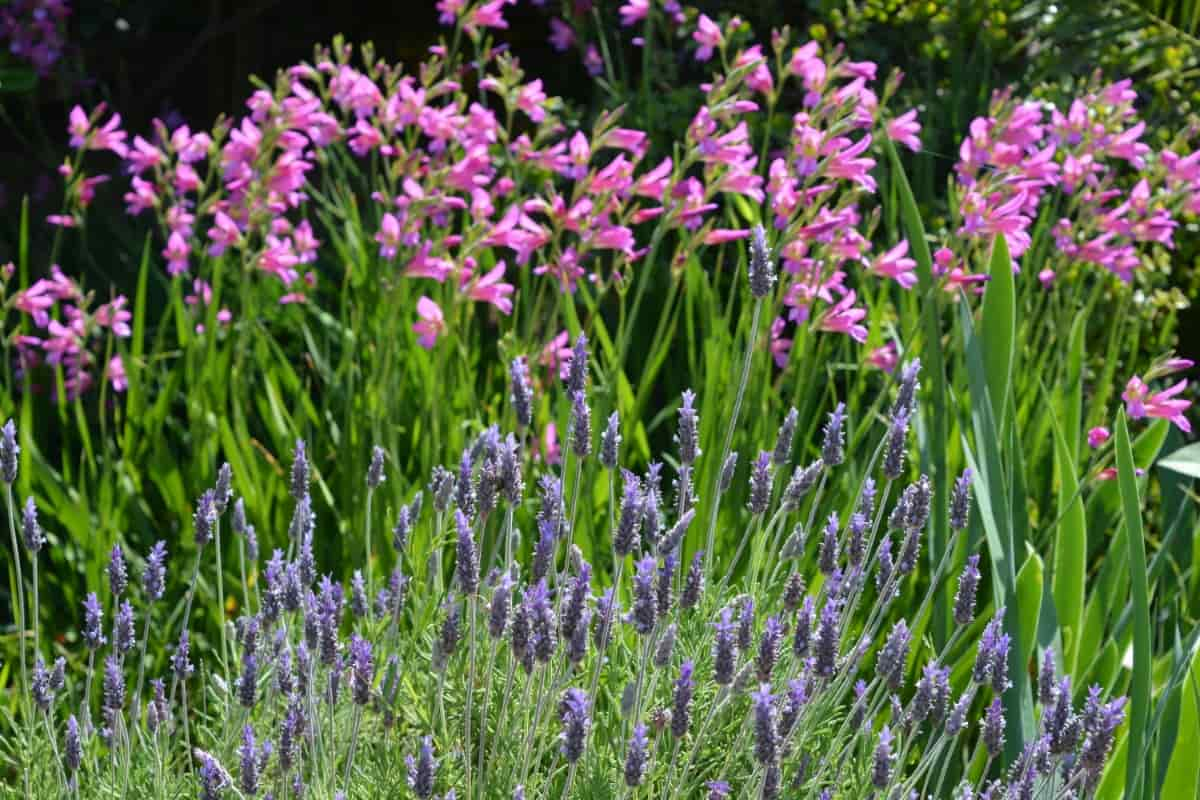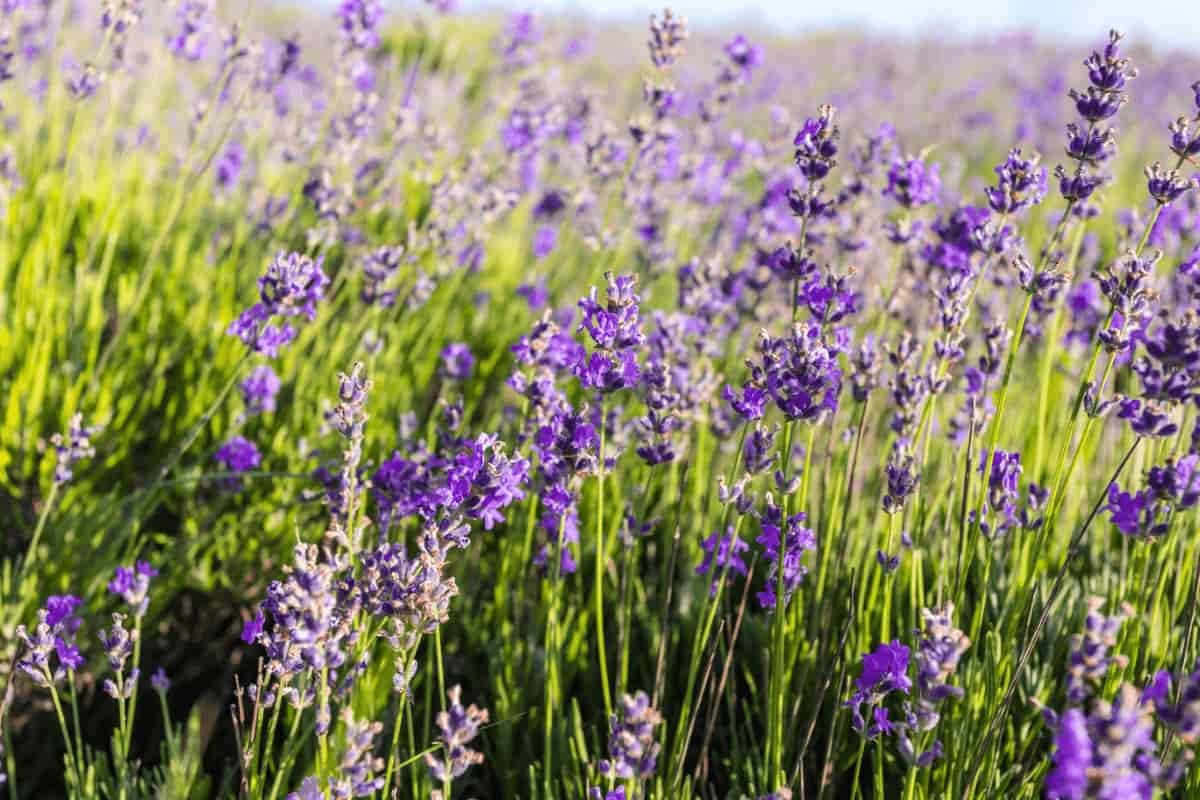Lavender, with its beautiful purple blooms and intoxicating fragrance, is a beloved perennial plant that has captured the hearts of gardeners for centuries. Its unique qualities make it a versatile addition to any garden or landscape. What grows well with Lavender? Rosemary, Sage, Thyme, Catmint, and Marjoram are the best companion herb plants for Lavender.

Bad Companion Plants for Lavender
Lavender thrives under direct sunlight and doesn’t do well when overshadowed by other plants. Impatiens, Hosta, Camellias, and Fuschia, are bad companion plants for Lavender.
Best Lavender Companion Plants
Rosemary (Rosmarinus Officinalis)
Rosemary is a versatile and aromatic herb that makes an excellent companion plant for Lavender. Both plants share similar growing conditions, making them perfect partners in the garden. With its needle-like leaves and delicate blue flowers, rosemary adds texture and visual interest to any Lavender bed. One of the reasons why rosemary is a great companion for Lavender is because they both thrive in full sun and well-drained soil.
These two plants are drought-tolerant and won’t compete for water resources. Planting them together can help create a microclimate that mimics their native Mediterranean environment. In addition to their compatibility regarding sunlight and water requirements, rosemary also offers some practical benefits as a companion plant for Lavender.
Its strong aroma repels pests like mosquitoes, aphids, and cabbage moths, which can harm Lavender plants. Furthermore, rosemary’s tall growth habit provides shade and protection from harsh winds for smaller Lavender shrubs. Rosemary and Lavender companion planting create an attractive display while promoting each other’s growth and well-being.
Sage (Salvia Officinalis)
Sage (Salvia Officinalis) is a versatile and aromatic herb that makes an excellent companion for Lavender. With its woody stems, velvety leaves, and beautiful purple flowers, sage adds visual interest and fragrance to the garden. One of the main benefits of planting sage with Lavender is its ability to repel several pests.
Sage contains natural compounds that act as insect repellents, making it a great defense against unwanted visitors like aphids and cabbage worms. By planting these two herbs together, you can make a natural barrier that helps protect your garden from pest infestations. In addition to its pest-repellent properties, sage complements Lavender regarding growth habits. Both plants thrive in full sun and well-drained soil, so they have similar watering needs.
Thyme (Thymus Spp.)
Thyme is a delightful herb that pairs perfectly with Lavender in the garden and the kitchen. With its small, delicate leaves and vibrant flavor, thyme adds a lovely touch to any dish. But it’s not just about culinary companionship; thyme also makes an excellent companion plant for Lavender. In the garden, thyme is a natural pest repellent, warding off unwanted visitors like aphids and cabbage worms.
In case you missed it: Frequently Asked Questions About Lavender Farming

Its aromatic fragrance is known to deter pests while attracting beneficial insects. This makes it an ideal partner for Lavender, which also attracts pollinators with its beautiful blooms. Both plants thrive in similar growing conditions – full sun and well-drained soil. Thyme’s low-growing habit contrasts Lavender’s upright form, adding visual interest to your garden bed or container arrangement.
Catmint (Nepeta Spp.)
Catmint is a fantastic companion plant for Lavender. Not only do they share similar growing conditions, but their vibrant colors and fragrant foliage create a stunning visual display in any garden. Catmint is known for attracting butterflies, bees, and other beneficial insects, making it a good choice for pollinator gardens. One of the great things about catmint is its versatility. Its compact size also makes it suitable for Lavender container companion plants.
Additionally, catmint has a long blooming season, producing beautiful spikes of Lavender-blue flowers from spring to fall. Another advantage of planting catmint with Lavender is that it helps repel pests like aphids and squash bugs. This natural pest control method reduces the need for harmful chemicals in your garden. To care for catmint and ensure its healthy growth alongside Lavender, provide well-draining soil and full sun exposure. Regular watering during dry spells will keep both plants thriving.
Marjoram (Origanum Majorana)
Marjoram (Origanum Majorana) is a wonderful companion plant for Lavender. Its delicate, aromatic leaves and pretty pink flowers add beauty to any garden bed or container. Marjoram is also known for its culinary uses, making it an attractive and functional addition. In terms of compatibility with Lavender, marjoram shares similar preferences when it comes to sunlight and watering needs.
Both plants thrive in full sun and well-draining soil, so they can be planted together without worrying about competing water requirements. Another reason why marjoram makes a great companion for Lavender is because it attracts beneficial insects such as bees and butterflies.
Yarrow (Achillea Millefolium)
Yarrow is a beautiful and versatile companion plant for Lavender. Yarrow adds color to any garden or landscape with its delicate yet vibrant flowers. Its feathery foliage creates an interesting texture that complements the fine leaves of Lavender. But yarrow is not just visually appealing; it also has many practical benefits as a companion plant.
It attracts beneficial insects, which help control pests in the garden. Yarrow thrives in full sun like Lavender, making them an ideal pairing for light requirements. Both plants prefer well-drained soil, so ensure proper drainage when planting them together.
Oregano (Origanum Vulgare)
Oregano is not just a flavorful herb to add to your favorite Italian dishes; it can also make a great companion plant for Lavender. With its similar preference for full sun and well-drained soil, oregano complements Lavender perfectly in the garden.
In case you missed it: How to Grow Lavender from Cuttings: A Complete Planting Guide

The aromatic leaves of oregano release an enticing scent that can help deter pests from attacking your Lavender plants. In terms of care, both plants have relatively low maintenance requirements. They thrive in dry conditions and don’t tolerate excessive moisture well. This makes them ideal companions as they require similar watering schedules.
Hyssop (Hyssopus Officinalis)
Hyssop is a fantastic companion plant for Lavender. Its vibrant purple flowers create a stunning contrast against the soft hues of Lavender blooms. One of the main advantages of planting hyssop alongside Lavender is its ability to attract beneficial insects like bees and butterflies. These pollinators play a crucial role in promoting overall garden health and productivity.
In addition to attracting beneficial insects, hyssop has medicinal properties that make it an excellent herb companion. Furthermore, hyssop and Lavender thrive in similar growing conditions – full sun and well-drained soil. This makes them ideal companions as they require minimal effort to maintain once established.
Lamb’s Ear (Stachys Byzantina)
Lamb’s Ear is a charming and distinctive companion plant for Lavender. Its soft, velvety leaves add texture and interest to any garden bed or container. The silvery-gray foliage of Lamb’s Ear contrasts beautifully with the vibrant purple flowers of Lavender, creating an eye-catching display. Lamb’s Ear is easy to care for and requires minimal maintenance. It prefers full sun, making it a versatile companion plant for Lavender in various growing conditions.
Alliums (Allium Spp.)
Alliums, with their distinctive globe-shaped flower heads and long, slender stems, are the perfect companion plants for Lavender. These unique flowers add height and visual interest to any garden bed or container arrangement. Their vibrant colors range from soft pastels to bold purples and pinks, creating a stunning contrast against the soothing hues of Lavender. In addition to their aesthetic appeal, alliums offer practical benefits when planted alongside Lavender.
In case you missed it: The Best Fertilizer for Lavender: When and How to Apply

They are known for their strong scent, which deters many common pests, such as aphids and slugs. This natural pest control makes them an excellent choice for protecting your beloved Lavender plants. Alliums are low-maintenance perennials that thrive in full sun and well-drained soil like Lavender. They require minimal watering once established, making them a great match for the drought-resistant qualities of Lavender.
Conclusion
Lavender is a versatile plant that can thrive in various garden settings, and choosing the right companion plants can enhance its overall health. Roses, Salvia, and Echinacea (Coneflowers) are the best companion flowers for Lavender. Lavender plants are not only beautiful, but they also have a wonderful fragrance that can fill your garden with a calming scent. Growing Lavender in containers is a fantastic option to add beauty to your garden space.
- Ultimate Guide to Ossabaw Island Hog: Breeding, Raising, Diet, and Care
- Ultimate Guide to Juliana Pig: Raising Facts, Size, Diet, Care, and Lifespan
- Raising Lleyn Sheep: Disadvantages, Price, Uses, Characteristics, and Care
- Ultimate Guide to Meishan Pig: Breed Facts, Breeding, Raising, and Care
- Ultimate Guide to Teacup Pigs: Raising, Diet, Lifespan, Cost, and Care
- Guide to Raising Poll Dorset Sheep: Facts, Profile, Characteristics, Uses, and Care
- Ultimate Guide to Bighorn Sheep: Characteristics, Diet, Lifespan, Breeding, and Lifecycle
- Ultimate Guide to Raising Katahdin Sheep: Farming Facts, Breed Profile, Uses, and Care
- Ultimate Guide to Raising Oreo Cows: Belted Galloways Farming Facts, Profile, Uses, and Care